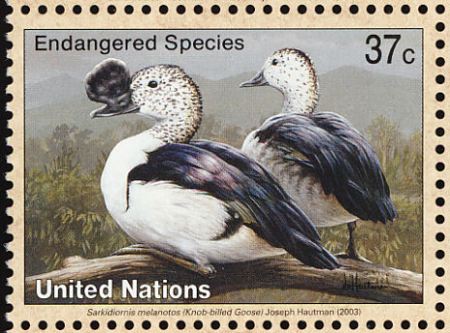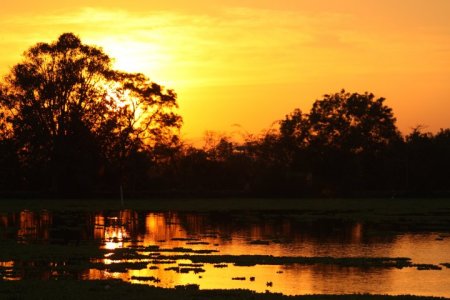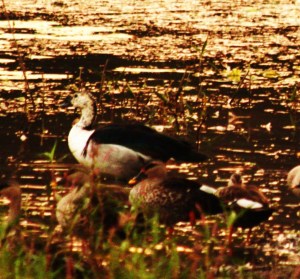Comb-ducks at a limpid pool
There is a quiet spot in the CME wetlands – where people do not go and where the dreaded water weeds have not yet come. Here the Blue Kingfisher flashes chestnut as he shoots across the clearing. Openbill storks roost every night in a tree along with herons and egrets and other storks. Just below the tree are many bushes, one of them Lantana. With the setting of the sun come the Hummingbird Hawk-moths (Macroglossum stellatarum) who sip the nectar from the little pink and yellow Lantana flowers, enjoying the last vestiges of cool weather before they vanish till the next winter.
Below the roost is a pond inhabited by those residents of CME who like the quiet life. Here the Spotbill population finds its headquarters, the Common Moorhen picks its way amongst the reeds and fish plop and create small ripples in the enjoyable silence. A hint of a fragrance from the pale green flowers of a tree add a master’s touch to this nature’s composition. At the end of a summer day, the crimson glow through the leaves colours the water rippled by the swimming of ducks.
Abhinav and I were there to pay obeisance to the Spotbill monarch when two white patches shone in the fading light on a bank opposite where the legions of Spotbill lay snoozing, bill under wing. At first they were indistinguishable; peering through a binoculars resolved them to be two large white duck with green-black markings, one of which had a curious growth on its beak, proclaiming to the world that they were Comb Duck or Nakta, a pair (Sarkidiornis melanotos).
They had decided to grace this small hidden spot which fitted their requirements. Attempts to photograph them were not successful as we did not have a suitable lens. A record shot is all that we could manage.
One of the strange misshapen looking ducks, the Nakta is found in Amazonia, equatorial Africa and Madagascar as well as South and Southeast Asia. Though having a wide range and hence not considered threatened, Comb Duck numbers are declining all over the world. They frequent well-wooded wetlands and usually nest in tree-holes, a habitat becoming rarer by the day. Shy of humans, they are easily disturbed.
 This gave me great happiness for two reasons. The trivial one was that our bird count went up by one more. The more important reason – it showed us that the CME wetland is vibrant and healthy – a rare thing in India today.
This gave me great happiness for two reasons. The trivial one was that our bird count went up by one more. The more important reason – it showed us that the CME wetland is vibrant and healthy – a rare thing in India today.
I pray to mother nature and all our Gods and Goddesses that this couple find this spot suitable and they be permitted to raise their family for many years to come undisturbed.
Image credits.
- Nakta stamp – Kjell Scherling (www.birdtheme.org) : Reproduced under fair use.
- Sunset & female Nakta – Abhinav Chawla (license Creative Commons Sharealike-attribute 3.0 unported).
Tags: birds, CME, Comb duck, Nakta, sunset, wetland
You can comment below, or link to this permanent URL from your own site.

18 March 2010 at 7:51 am
A wonderful and enlightening post… as always.
I wasn’t aware of the Comb Duck or Nakta… but now I know. Thanks to you…
P.S. I second your thoughts and prayers.
18 March 2010 at 9:00 am
Hi Roshmi, always a pleasure to see you here! Nice to hear you are back safe and sound though people like me get frightened by the image on your blog! 😉
18 March 2010 at 10:09 am
Thanks for the lovely and enlightening article, Ashwin ji. I have often spotted the comb duck at Bhigwan.
18 March 2010 at 2:35 pm
Hi Alaka, we are missing you at the lake!
18 March 2010 at 4:52 pm
Amen. May the fauna be safe and multiply
22 September 2016 at 1:18 am
Fantastic blog! Have visited the CME a few times 🙂